| Article ID | Journal | Published Year | Pages | File Type |
|---|---|---|---|---|
| 4280393 | The American Journal of Surgery | 2009 | 7 Pages |
BackgroundObstructive jaundice is frequently associated with false CA19-9 elevation in benign conditions. The diagnostic accuracy of this tumor marker was evaluated in the present longitudinal study.MethodsIn 128 patients admitted for obstructive jaundice (87 with pancreato-biliary malignancy and 41 benign disease) serum CA19-9 was measured. Statistical analysis of marker levels obtained before and after endoscopic biliary drainage was performed in 60 patients.ResultsElevated CA19-9 levels (>37 U/mL) were found in 61% of benign cases and 86% of malignancies. After biliary drainage, decrease of serum CA19-9 was observed in 19 of 38 malignant cases and in almost all benign cases (Wilcoxon matched pairs test: P = .207 and P <.001, respectively). Receiver operating characteristic (ROC) analysis identified a cut-off value of 90 U/mL to be associated with improved diagnostic accuracy after biliary drainage (sensitivity 61%, specificity 95%).ConclusionsIn the presence of successfully drained obstructive jaundice, CA19-9 serum levels that remain unchanged or measure more than 90 U/mL are strongly indicative of a malignant cause of obstruction. However, the real clinical utility of this marker remains controversial.
